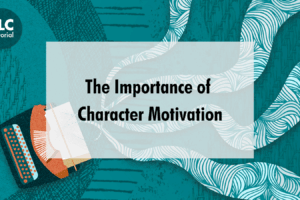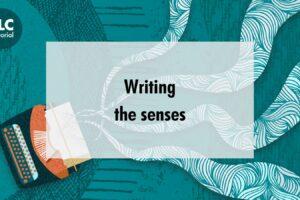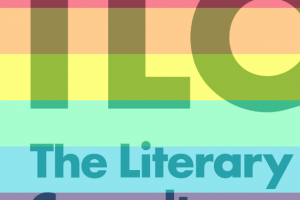My journaling adventure began officially on the 28th day of the second month of the year 1986. And like that first sentence my first entry spelled out a seemingly unnecessary amount of information that involved birthdays, family names and rooms. I was eight years old.
I don’t know what possessed me to pick up a biro that day and begin my relationship with the written word, but I do know that I enjoyed it. I must have. Even as a child there was something about capturing memories through writing that made it worth doing.
‘This is the story of all of us,’ I write, ‘Me, my brother, films, my mum, cartoons and my dad.’ Clearly in some random order. I hope. I can only promise that films and cartoons do NOT come before either of my parents in terms of importance or any other terms.
And so, began a long period of sporadic, dipping into my life of writings, musings and reflections that we now term as journaling.
In the early years I had the bug for diary entry. It became addictive. But then times came when I’d force myself to write each day. And when I did that it felt like a chore. Those forced days were the ones spent during secondary school. I’d come home and think about what had happened and reduce the day to a few sentences for the sake of it. I felt guilty if I missed an entry. But that’s not how journaling should be.
After a while I learned to write only during the days that I wanted to write. It was a pleasure to do it. But that left gaps of days that glare at me as if shouting ‘WHAT HAPPENED TODAY?’. I eventually ignored them and did what I wanted when I wanted. It shouldn’t be a chore.
I even took to recording some memories through a Dictaphone. I kept a record of days that filled three miniature cassettes which I have stored away. But the practicalities of a writing journal outweighed that of a speaking one. For one thing it was hard to flick through a cassette, and it doesn’t help that I cringe hearing my own voice telling me how much fun it was watching Terminator 2 for the first time with my parents. Back to tactile writing it was: from heart to hand to page.
So, what do I populate my journals with? Well since I’ve made the decision to become a writer full time, my focus here will be on seven examples of way I’ve used of my own personal journal:
1. Career transformer: I keep a communication ledger recorded at the back of each of my journals. This is my tool for listing all the opportunities that I’ve ‘shipped’ out. Some I win some I lose. Emojis are handy for an instant display of good ? or disappointing news ☹.
A communication ledger sounds fancy when you realise it’s a simple table with Date – Note – Result. That’s it. But I’ll be fancy if I fancy it.
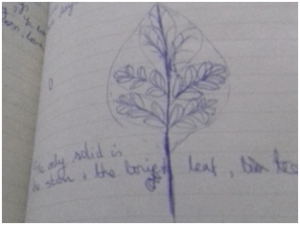
2. Puzzle creator and Problem Solver: This is where I get to explore my mind in lateral ways. I’ll have an idea for a plot or even a puzzle. That’s a maze in one of my stories that developed, and I started to scribble away a solution. A brainstorming with design. Sketching my protagonist a way out of the maze was one option and another was to write them through it. It took me a while to realise that the sketch gave me a glaringly obvious answer. Here’s a fern fractal leaf sketch which I turned into a maze in that very story.
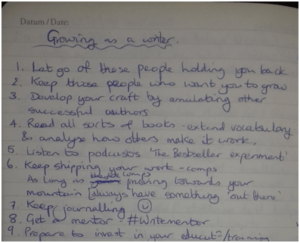
3. Wisdom enhancer: Whenever I watch a motivational Youtube video or read something profound or even think up what I would deem a great saying of mine that I wish the world to not know about, I’d jot them down on my journal and enjoy them for later nuggets to mull over when a time comes that I’ll reflect over. Here’s a checklist I’ve harvested to help me grow as a writer.
4. Comedic companion: recently I took to my journal to air my frustrations as a writer by exchanging with myself against the crazy wold of writing:
Me: I want to write a story. Here you go Writing World. Love me now.
Writing world: Fine. If you must, but first rule to writing is ‘show don’t tell’.
Me: Okay, sure. Show don’t tell. *removes all telling*
WW: No adverbs and adjectives. Don’t be lazy.
Me: Righty ho. Nouns and verbs it is. *punches keys with gusto*
WW: Stop with the passive. Put into active.
Me: Fine. *searches through all the ‘to be’ forms* Here you go.
WW: Details – put us closer to your character.
Me: Oooh – good point. *does some running, parkour and loses 3 stones, comes back to story 6 months later*
WW: Read more. MORE.
Me: Wonderful. Of course. I know that. *Joins course by Penny Joelson to analyse children’s books*
WW: Get a mentor.
Me: Yes! *wins an amazing mentor through #writementor* [Emma Finlayson-Palmer is fabulous!]
WW: Nearly there keep writing and reading.
…you get the idea. It goes on for a bit but it’s a fun exercise to take one out of the process and reflect on the to-ing and fro-ing going on. Sure, it sounds like I’m talking to myself but it’s a writer’s life.
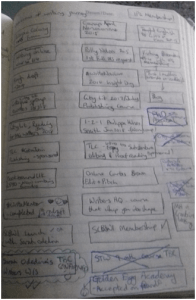
5. Career mapping: Sometimes it’s difficult to see how much one has accomplished when the goal is the long journey of having a book traditionally published. Butthere are lots of steps that come into play and it gets very frustrating when things are not going the way it’s expected to.
A stepping stone journey map of what I’ve achieved so far is a great technique to jot down and visually see one’s achievements. Using a box for each step and building it through in a sequence. A box for first draft completed. A box for full submission request from agent. A box for every course and event attended. Completing Nanowrimo, competitions won and so on. They all add up to a create portfolio of a writing experience that should be celebrated and never forgotten.
6. Poems collection: I don’t normally write poetry and I certainly don’t call any of my writings that, but occasionally I’m gripped with something that I want to put down that doesn’t always seem to fit anywhere in the world. So, into the journal it goes:
I’m the kink in you armour
The spanner in your works
I’ll unravel before you
With the pull of my threads
As your world collapses
Your bare soul will reveal
The truth of your heart
The hate that you feel.
I didn’t say they’re great, but it works as a tit bit of emotional release at the time.
7. Infographic of a writer: So here it is. The great messy culmination of my learning experience as a writer. Summarised as an infographic from my journal. Warning, it isn’t pretty…

Today and every day, I daren’t leave the house without my journal. I have too many thoughts and opinions to keep inside of me. And whilst social media helps us capture some memories it’s the non-filter property of my personal journal that feels both cathartic and therapeutic to vent out without any worry of professional consequence or misunderstandings that might result in sharing it publicly.
Sometimes I forget that writing (and speaking for that matter) is only an approximation of our analogue thoughts. It’s like the original digital conversion of an analogue signal. (Yes, I will continue with a physics analogy as a physics grad). We have so many thoughts that it becomes an art in itself to be able to convey them accurately in a pictorial or writerly way. And if I do it just so, it might even resonate with another who will transpose those written characters and translate them into their own thoughts that are in complete harmony with the original ones. That’s the heart to heart magical experience we feel when something ‘clicks’ between all of us.
But ultimately my journal is for me. And I will use it as a tool to sharpen my own writing and observations. Cathartically I record both the happy days and the dark days. But sometimes I do wonder what reasons I write when I read back some of those odd days. Here is a short extract of one I will title as ‘The One I sat on a bench to watch birds’:
‘Pigeons are pecking at crumbs on the ground. A crow bites on a beak-full of food bigger than its face. Seagulls fly overhead. I hope they don’t poop on me…They really do look like they’re trying to take aim at times. There goes another one.’
I can’t say honestly why I write the things I write but it seems, like my 1986 self, some of my writing really is quite random. Others not so random like this extract:
‘I am in a dark place – hurting – sinking – not tired – just hurting. Trying to reach out to others but I need to confront a few things in myself first…’
And then there are the years that where there are no journals to show. Not because I didn’t write during those years but because I destroyed them. The absence of those journaling years have left a painful gap. I had kept a journal for every year since I began in 1986 even if I had a handful of days to record. I always had something of my thoughts for each year of my life, written and stored.
Then something happened during my twenties. I took all the journals I could find and ripped them into as many pieces as I could. Throwing them into the bin. Gone. Those journals celebrated my life, my memories, my existence. And yet a time came when existing was a shameful thing. It’s hard to admit to others but to destroy a piece of writing so personal because it represented a part of me that the act itself was a form of self-flagellation that I will always regret. I punished myself in doing this act and I knew it.
Since then I reduced my adult life into a series of diary entry of appointments. Notebooks replaced journals as I only jotted down business ideas and projections instead of life moments and reflections.
It was only once I seized hold of my life and changed my career that I rediscovered journaling again and love for it. It is a profound part of me that I had denied for a long period.
Now I never leave home without three items: a journal, an appointment diary or a notebook. Each has had a practical, personal and emotive purpose one way or another during the course of my past, present and future writings.




